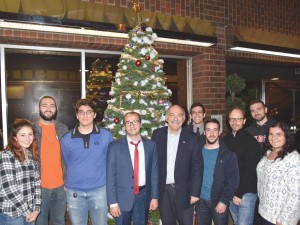
Photo: Hourig Attarian
Michael Rettig
Editor
Reconstructing historic life in the Ottoman Empire has been difficult for the Armenian people because of the cataclysmic rupture the Genocide engendered between the Armenians and their past. Birth records were destroyed, churches burned, and populations eradicated. This has made it increasingly important for Armenians to utilize the remaining fragments of their past to piece together their history. Kazan Visiting Professor (Fall 2016) Dr. Khatchig Mouradian demonstrated the importance of this process in his illustrated presentation on “The Tale of Two Midwives: The Notebooks of Siphora and Nuritza Shnorhokian of Aintab, 1890-1930” on November 30, 2016. This was his third and final lecture in the series “Genocide and Resilience” as part of the Fall Lecture Series of the Armenian Studies Program.
Dr. Mouradian stumbled by accident upon the notebooks of two midwives from Aintab, Siphora and Nuritza Shorhokian, when his friend mentioned having them in his possession. The Shnorhokian sisters delivered thousands of babies in Aintab from various religious and ethnic backgrounds between the end of the nineteenth century and the beginning of the twentieth century. Their notebooks contained detailed information such as the names of the infants they delivered, family backgrounds, and child mortality rates.
Dr. Mouradian did not know how he would use the notebooks, but recognized their historic significance and proceeded to scan them. His opportunity to utilize the notebooks came when scholars from Aintab (Turkey) invited Dr. Mouradian to speak for the Armenian Genocide Centennial in 2015, the first commemorative event of its kind in Aintab. Dr. Mouradian explained that he did not want to give a mere historic account of the Genocide, but wanted to connect his largely Turkish and Kurdish audience to the event on a more personal level.
“Often, the best way to reach audiences is not to go into details about what happened, but to try to connect with them using stories that mean something to them,” said Dr. Mouradian, who realized that the story of the Shnorhokian sisters would be the perfect connection between the Genocide and his audience in Aintab. “When I look at you, I can’t help but wonder if your ancestors were born into the hands of these Armenian midwives. Theirs would have been the first hands to hold your grandparents or great grandparents. If you want to honor your own history, you will honor the history and the memory of these women as well.” Curious natives of Aintab have since approached Dr. Mouradian wondering if their ancestors were listed in the notebooks.
According to the Shnorhokian notebooks, the number of Armenian births in Aintab decreased after the Genocide, while non-Armenian births increased. He told his audience in Aintab, “you know why.” Dr. Mouradian explained that he did not have to use the word “genocide,” but rather let the sources speak for themselves. He explained that the Shnorhokian sisters were forced to leave Aintab in 1923. “You know why. They were forced to leave their home town, only able to return 100 years later as a story.”
Nuritza and Siphora arrived in Aleppo after the Genocide, where their notebooks revealed that they delivered Armenians from various provinces of the Ottoman Empire, all of whom ended up in Aleppo as a result of the deportations. Dr. Mouradian was thus able to use the notebooks to further corroborate evidence of the Armenian Genocide and to personally connect the history to the contemporary residents of Aintab.
Furthermore, Dr. Mouradian explained that the notebooks added to the historic record of midwives in the Ottoman Empire. Most current records detail the lives of midwives who served the upper echelons of Ottoman society, rather than the commoners’ midwives.
Dr. Mouradian concluded his lecture by highlighting the selfless nature and resilience of the Shnorhokian sisters in performing their duties during such a tumultuous period of Armenian history.
The sisters helped mothers of all backgrounds through the entire process, from pregnancy to birth, and beyond, without seeking to profit from their customers. Dr. Mouradian explained that the sisters visited mothers after their infants had grown and asked to borrow the infants’ old clothes to donate to more recent mothers.
“These women were extremely selfless. We talk about heroes on the battlefield, but it’s important to note that not all heroes are on horseback, and not all heroes carry weapons. These two sisters played such a key role in the life of a community at a time when the community was essentially oscillating between survival and destruction.”
“Ultimately these different pieces of Armenian history allow us to think about the Armenian experience in a way that is different. It shows us not only the extent of our loss, but the resilience and dedication of these individuals who survived and thrived.”
 Hye Sharzhoom Armenian Action
Hye Sharzhoom Armenian Action